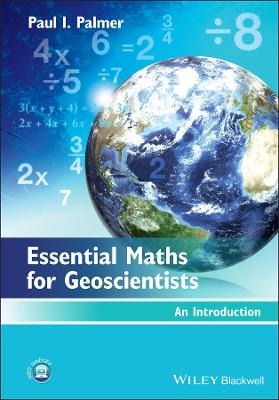
Essential Maths for Geoscientists
Wiley-Blackwell (Verlag)
978-0-470-97194-9 (ISBN)
Essential Maths for Geoscientists
An Introduction
Essential Maths for Geoscientists: An Introduction is an accessible, student-friendly introduction to the mathematics required by those students taking degree courses within the geosciences. Clearly structured throughout, this book carefully guides students step by step through the first mathematics they will encounter and provides numerous applied examples throughout to enhance students’ understanding and to place each technique in context.
Opening with a chapter explaining the need for studying mathematics within geosciences, this book then moves on to cover algebra, solving equations, logarithms and exponentials, uncertainties, errors and statistics, trigonometry, vectors and basic calculus. The final chapter helps to bring the subject all together and provides detailed applied questions to test students’ knowledge.
Worked applied examples are included in each chapter along with applied problem questions which are a mix of straightforward maths questions, word questions and more involved questions that involve the manipulation and interpretation of real and synthetic data.
The emphasis in the book is on the application of relatively rudimentary mathematics to real-life scientific problems within the geosciences, enabling students to make use of current-day research problems and real datasets.
Paul I. Palmer School of Geosciences, University of Edinburgh, UK
Preface xi
1 How Do You Know that Global Warming is Not a Hoax? 1
2 Preamble 7
2.1 The scientific method: pushing back the frontiers of ignorance 7
2.2 Subscript and superscripts 9
2.3 Scientific number format 10
2.4 Significant figures and rounding numbers 12
2.5 Units and dimensions 13
2.6 Symbols and numbers 14
2.7 Mean, median and variance: commonly encountered statistics 15
2.8 Guesstimation 19
2.9 Exercises 21
3 Algebra 37
3.1 Introduction 37
3.2 Evaluating algebraic equations 37
3.2.1 Preamble: symbols and numbers 37
3.2.2 Powers, roots and bases 38
3.3 Simplifying algebraic equations 39
3.4 Factorization 44
3.4.1 Factorizing quadratic equations 46
3.5 Transposing formulae 46
3.6 Word problems 49
3.7 Exercises 50
4 Solving Equations 53
4.1 Solving linear equations 53
4.1.1 Graphically 54
4.1.2 Analytically 58
4.2 Solving simultaneous equations 58
4.3 Solving quadratic equations 59
4.3.1 Square roots 60
4.3.2 Completing the square 60
4.4 Exercises 62
5 Logarithms and Exponentials 67
5.1 Exponentials 67
5.2 Logarithms 67
5.2.1 Logarithm laws 68
5.2.2 Solving exponential equations 69
5.2.3 Power laws and scaling exponents 69
5.3 Log-normal and log–log plots: when and how to use them 72
5.4 Exercises 74
6 Uncertainties, Errors, and Statistics 77
6.1 Errors 77
6.1.1 Important definitions 78
6.1.2 Measures of error 80
6.2 Combining errors 83
6.2.1 Equations with one variable 83
6.2.2 Equations with two or more variables 84
6.2.3 Linear equations 84
6.2.4 Products 85
6.2.5 Combining results of different experiments 86
6.3 Statistics 87
6.3.1 Graphs 87
6.3.2 Descriptive statistics 89
6.4 Correlations 91
6.5 Exercises 93
7 Trigonometry 95
7.1 Some geoscience applications of trigonometry 95
7.2 Anatomy of a triangle 96
7.3 Angles: degrees and radians 99
7.4 Calculating angles given a trigonometric ratio 100
7.5 Cosine and sine rules for non-right-angled triangles 101
7.6 Exercises 101
8 Vectors 105
8.1 What is a vector? 105
8.2 Resolving a vector 105
8.3 Vector algebra 107
8.3.1 Adding and subtracting vectors 107
8.3.2 Multiplying a vector by a scalar 107
8.3.3 The resultant of two perpendicular vectors 107
8.4 Resolving non-perpendicular vectors 108
8.5 Exercises 110
9 Calculus 1: Differentiation 113
9.1 A graphical interpretation of differentiation 114
9.2 A general formula for differentiation 116
9.3 The derivative of some common functions 118
9.4 Differentiation of the sum and difference of functions 118
9.5 Higher derivatives 120
9.6 Maxima and minima 120
9.7 Exercises 122
10 Calculus 2: Integration 125
10.1 Introduction 125
10.2 Definite integrals 127
10.3 Numerical integration 129
10.4 Exercises 130
11 Bringing It All Together 133
A Answers to Problems 143
A.1 Chapter 2: Preamble 143
A.2 Chapter 3: Algebra 148
A.3 Chapter 4: Solving Equations 152
A.4 Chapter 5: Logarithms and Exponentials 158
A.5 Chapter 6: Uncertainties, Errors, and Statistics 162
A.6 Chapter 7: Trigonometry 166
A.7 Chapter 8: Vectors 171
A.8 Chapter 9: Differentiation 174
A.9 Chapter 10: Integration 179
A.10 Chapter 11: Bringing it all together 182
B A Brief Note on Excel 197
C Further Reading 199
Index 201
| Verlagsort | Hoboken |
|---|---|
| Sprache | englisch |
| Maße | 170 x 244 mm |
| Gewicht | 336 g |
| Themenwelt | Mathematik / Informatik ► Mathematik |
| Naturwissenschaften ► Geowissenschaften ► Geologie | |
| ISBN-10 | 0-470-97194-0 / 0470971940 |
| ISBN-13 | 978-0-470-97194-9 / 9780470971949 |
| Zustand | Neuware |
| Informationen gemäß Produktsicherheitsverordnung (GPSR) | |
| Haben Sie eine Frage zum Produkt? |
aus dem Bereich


